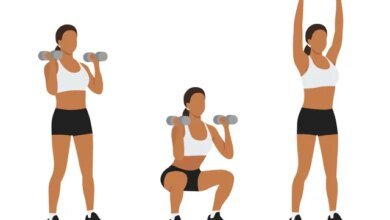How To Use Stair Climbing Intervals for Weight Loss

Let’s be honest: There’s something special about lacing up your sneakers and going on a brisk walk. Whether you head outdoors into the sunshine or to your treadmill, you’re moving your body, getting the endorphins flowing, and breaking a sweat. However, if you’re ready to take your daily steps to the next level, we’re here to introduce stair climbing intervals, which will help you burn more calories and upgrade your cardio days.
If you’re wondering how stair climbing intervals work, we’re here to break them down and share the benefits of adding this form of training to your fitness routine.
What Are Stair Climbing Intervals?
Intervals require you to alternate between bursts of high-intensity and low-intensity exercise during your workout.
“It creates a cycle where you do more than you can handle and then do less than you can handle,” explains Domenic Angelino, CPT with International Personal Trainer Academy (IPTA). “When this is applied to stair climbing, you run up the stairs very fast during one [training phase], then walk or slowly jog up the stairs for the next. The exact speed you go at during the recovery phase should depend on your current level of fitness. It’s important that you go slow enough to allow your body to recover a little without actually coming to a full stop.”
You can practice stair climbing on a stair climber machine or classic stairs in your home or outdoors; however, Angelino recommends opting for the machine to avoid the risk of falls. If you choose normal stairs, be sure to take proper safety measures and only use stairs with ample surface area. It’s also helpful to wear shoes that aid with friction to decrease your risk of tripping.
“It’s important to emphasize that running up normal stairs is not normally recommended for most people given the unnecessarily high risks associated,” Angelino adds. “The only exception for this is for athletes who have unique sport-specific training needs. It’s better to use a stair climber machine when possible.”
How Can Stair Climbing Intervals Help You Lose Weight?

Incorporating stair climbing intervals into your routine can be incredibly beneficial—especially if you’re trying to lose weight. Stair climbing intervals burn more calories than workouts of similar durations that are completed at a consistent place.
“Burning more calories means losing more fat,” Angelino points out. “If you want to lose around one pound per week, you should aim to burn about 500 more calories than you eat [daily]. If you want to lose around two pounds per week, you should aim [to burn] around 1,000 more calories than you eat each day. Try to cap weight loss at an average of two pounds per week unless otherwise advised differently by your doctor.”
In addition to the high calorie burn, interval training puts a high demand on your body. That means you run at a fast speed you can only maintain for a short period of time, then assume a slower pace, and then continue to alternate between the two.
“You fit in a large number of high-intensity periods of training into one workout,” Angelino explains. “Interval training allows you to burn a large number of calories during your workout and also after it ends.”
How To Use Stair Climbing Intervals To Lose Weight:

There are many ways you can implement stair climbing intervals into your regimen. (Keep in mind that if you also perform strength training, Angelino recommends saving that session for a separate day.)
When it comes to the best stair climbing interval workout, Angelino suggests several options depending on your fitness level and how much time you have to spare:
Easier
- 9-minute session, switching between 30 seconds of high-intensity exercise and 30 seconds of low-intensity exercise.
- 20-minute session, switching between 2 minutes of high-intensity exercise and 2 minutes of low-intensity exercise.
- 30-minute session, switching between 1 minute of high-intensity exercise and 1 minute of low-intensity exercise.
Harder
- 9-minute session, switching between 1 minute of high-intensity exercise and 30 seconds of low-intensity exercise.
- 15-minute session, switching between 2 minutes of high-intensity exercise and 1 minute of low-intensity exercise.
- 25-minute session, switching between 3 minutes of high-intensity exercise and 2 minutes of low-intensity exercise.
Alexa Mellardo





